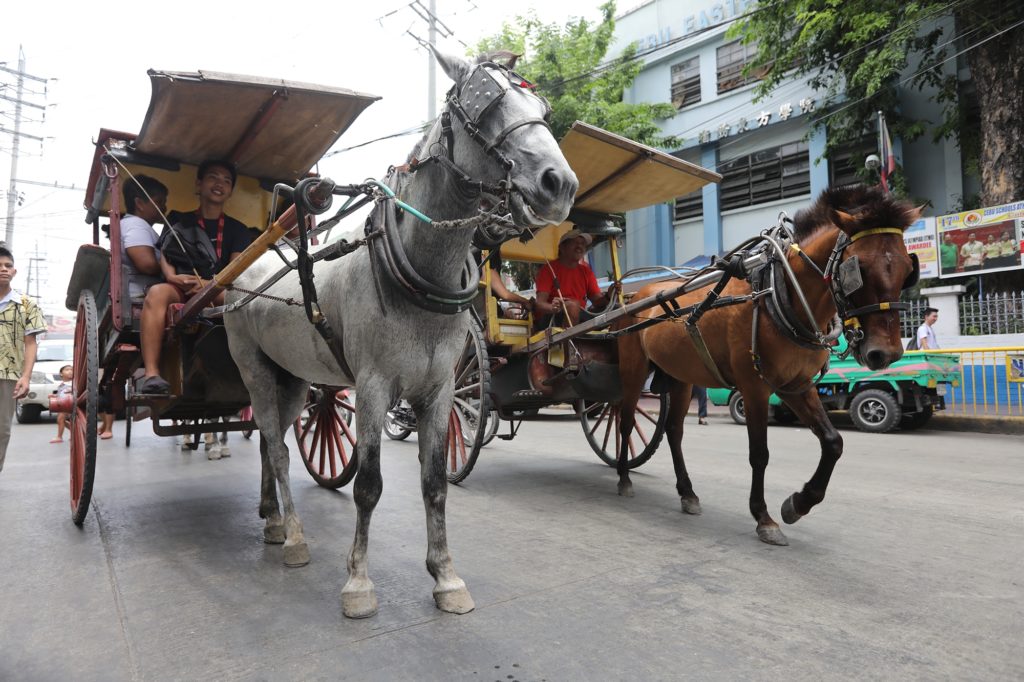
The tartanilla, yesterday’s premier mode of transport is now overtaken by time and machines.
Jeepney drivers are unabashedly considered the “king of the road” as this unique Filipino mode of public transport has become a necessity for most commuters.
However, about a century ago, the streets were ruled by coachmen on board colorful horse-driven carriages locally known as tartanilla or parada.
The coachmen or kutsero drove the two-wheeled carriages with their horses traversing the city’s major roads.
The arrival of motorized vehicles in the Philippines in 1901, saw a slow decline in the popularity of the tartanilla.
Even more with the implementation of various city ordinances that brought about the decreasing numbers of tartanillas in Cebu City.
From over 400 paradas in the 70’s and 80’s, only about a hundred are left traversing the streets of Leon Kilat, Duljo-Fatima and Pasil, said Cebu City Transportation Office (CCTO) operations chief Francisco Ouano.
But for as long as there are people who choose to ride the tartanilla over the more popular jeepneys, there will be kutseros ready to serve them in places where they are allowed.
One of them is 47-year-old Victor Abellanosa who has been braving the car-dominated streets as a coachman for 22 years.
Abellanosa learned to hold the horse’s reins from his relatives when he was only a teenager; but he became a kutsero at 25 years old.
He recalled that it was difficult at first until he eventually got the hang of it with a little more practice and experience. “Lisod kay bag-o pa man, kadugayan di na ko maglisod kay naanad na man (It was hard at first, but after a while, I got used to it),” Abellanosa said recounting his early days as a coachman.
On the average, Abellanosa earns about P500 per day working on the road, but there are times when his earnings would go up to P600, which he considers a fairly huge amount.
To rent a carriage and horse, Abellanosa pays P200. He then keeps P200-P300 a day as income.
The money, he said, was enough for his family to survive for a day.
Coming from a long line of kutseros, Abellanosa said that he could not think of any other means of livelihood, as it was his childhood dream to be on a horse carriage like his relatives before him.
He fondly recalled the awe he felt when he first saw the wooden contraption as a child.
Eager to drive a horse carriage, Abellanosa took to the streets early in life and only managed to complete second year of high school.
Like Abellanosa, 48-year-old Andy Raagas has been driving a tartanilla for several decades.
Raagas trained at a well-known stable in Barangay Duljo-Fatima Cebu City, a village known to many as the home of tartanilla makers.
“Mao ra man ni akong nakahibaw-an so kani nalang akong gibuhat (This is the only thing I know, so I decided that this is what I will do),” said Raagas, a high school graduate.
When he started as a coachman in Duljo-Fatima, some 30 years ago, the fare was only 10 centavos, said Raagas.
Today, passengers are charged between P6 to P10 for a ride while the routes of the tartanilla have been regulated to avoid traffic congestion in major thoroughfares.
A city directive limiting tartanilla routes to Barangays Pasil and Duljo Fatima in Cebu City’s San Nicolas district and Magallanes Street at the downtown area was passed in 2007.
“Nausab na man gud ta, mugamit na ta og motor vehicles,” (We’ve changed. We now use motor vehicles) said Redosel Gabumpa of CCTO’s legal department on the need to limit the routes of tartanillas.
Other city ordinances also require the registration and licensing of rigs and rig drivers as well as the payment of a license fee for coachmen.
To determine their capability in handling horses prior to their operation, coachmen are required to pass an examination.
Along with regulating the operation of tartanillas, Cebu City regulations also provide penalties for violators such as the confiscation of their tartanillas.
For humanitarian reasons, erring coachmen are allowed to keep their horses, said Ouano.
Violators will be made to explain why they strayed away from their routes and will need to attend a seminar on tartanilla regulations.
“Gi allow gyud na sila sa una tungod kay apil gyud na siya sa atung public transportation, but karon limited na ilang rota. Apil gyud na sila sa pagpahinabuhi (It was allowed in the past because it was considered part of public transportation, but now they only have a shorter, limited route. We also have to consider the coachman’s livelihood),” added Ouano.
Raagas was once apprehended for driving without a license.
“Wa lang gyod mi nireklamo, para walay gubot (We just didn’t complain to avoid conflict),” said Raagas who continues to fight for his place in the crowded streets of Cebu City along with his trusted horse.
There is no other job for him, he said; and he will remain as a symbol of a past culture that cannot be erased. /Gerard Vincent Francisco, Delta Dyrecka Letigio and Zena V. Magto, USJ-R Interns
(To be concluded…)
Disclaimer: The comments uploaded on this site do not necessarily represent or reflect the views of management and owner of Cebudailynews. We reserve the right to exclude comments that we deem to be inconsistent with our editorial standards.
